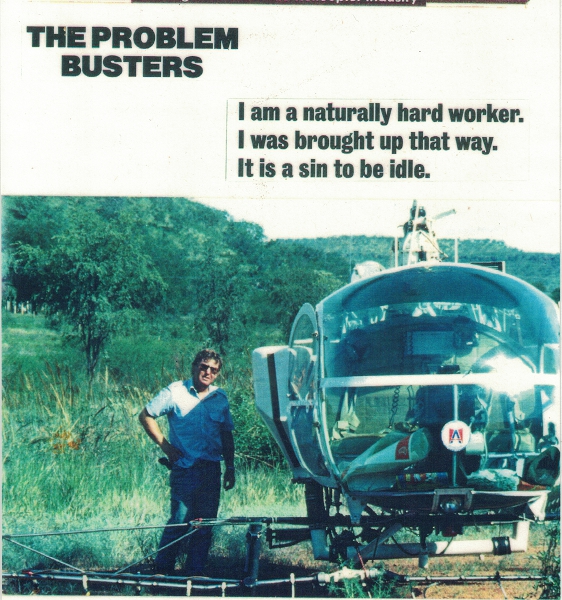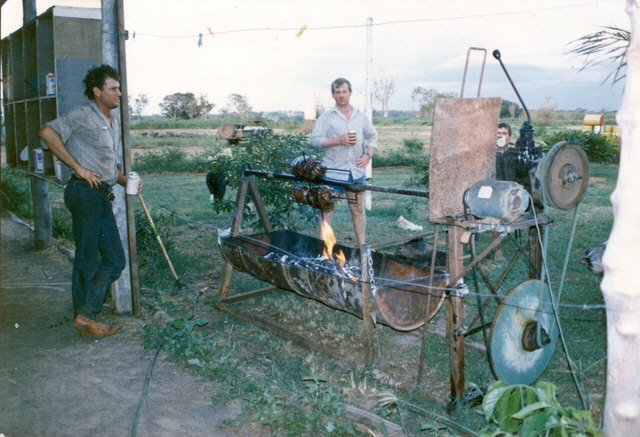The wet season
(monsoon) in '89 up in the Northern
Territory flood plains was really steamy.
Those who have
been there during January know that 45 degrees C and
+90% humidity, with heavy tropical thunderstorm
downpours,
are an every day show of beautiful
mother nature.
Working a
Hiller UH12E out of
a floodwater isolated buffalo station called
Opium Creek (that’s another story)
on the Mary river flood plains, I
had won a Government contract and was aerial
spraying the noxious prickly shrub Mimosa Pigra for the NT
Govt. (more
info)

Some days were
simply too hot, humid or stormy even for
the system I had developed for
effective helicopter Tropical
climate spray
application above 25C.
Because of the
problem with the "big lizards" (man eating saltwater crocodiles) on
the flood plains, I always carried a
stainless steel Ruger .38 pistol and
a Sako .243 rifle in the machine in case
I survived the crash if something
went wrong.
I still get little
flashback thoughts of "what if it
really happened" and I was left
only a foot or so out of the water sitting
hunched up on
what was left of the rotor head of the helicopter with
only one cartridge left
and a couple or more big hungry crocs
were eyeing me up – maybe General Custer
felt the same about the Indians at
Bighorn.
It was the
Australia day holiday - January 26.
The two
previous repugnant days had been
stifling – too hot to
spray because of the overcast and almost
100% humidity, so Joe, the station
manager, asked me if we could use
the helicopter to do a
bit of aerial wild feral pig culling
instead.
Not needing extra
encouragement - away we went blazing
at every pig we could see – not a
hard thing to do from the air as
they were slowed by the muddy
conditions while trying to escape thru the flood
plain shallows.
Some of the
oinkers looked to be in prime
condition and we salivated as we
thought of them being a better feed
than the tins of food we had been
heating up for the last week or so.
I gently
lowered the skids
about 6 inches into the water and told
Joe to get out and tie a couple of
dead pigs onto the cargo hook
underneath the helicopter so that we
could take them home.
I was hoping
that the helicopter rotor down wash was
enough to keep those hungry lizards
away as I would have had trouble
getting airborne again if a two
ton reptile jumped over the skid
and locked onto Joe - or even worse - one
of the dead pigs.
The problem
started when we got home – everyone
knows that wild pig has to be cooked
hot and right through to get rid of
any parasites which could
decommission your stomach and a few
other things. However you can’t cook
a pig in an LPG stove which has run
out of gas just at the wrong time.
Two of the
Station ringers were cane farmers
from Queensland who were up in the Northern Territory
to earn a bit of extra cash and see
what all the excitement was about.
These boys were Oz ingenuity at its
best.
“You mob go and
have a few Coldies (beer) – we’ll sort this
out” was their enthusiastic catch cry whenever
their services were needed.
On this
particular day they did well.
After we had a
bit of a wash to get clean while standing
outside in a warm tropical downpour, Joe and I
retreated into the homestead for a
semi cold beer with his family and
have a yakkity
yak.
It was getting
on late in the afternoon when I woke up
from a well deserved nana nap on the
rickety old couch
to the quiet and welcome sound of no rain on the
tin roof and the tantalizing
aroma of pig cooking over
an open fire.
Joe was outside
supervising the cane farmers'
newly built contraption and what a sight it was.
They had raided
the station rubbish dump and made a
BBQ spit.
The container for the wood was a 44
Gallon (200 litre) AVGAS fuel drum gas-axed
vertically which they then butt welded end to
end.
Over this they
has welded up a sort of A frame at each
end and, after utilising an old washing
machine electric motor, pulleys from
something else, a spare generator
plant belt, the tail shaft out
of an old car and the gearbox out of
a wrecked Suzuki 4WD, the pig was
now turning and roasting over the hot
coals.
“Boys” I said –
“Boys you have done well”
“TC” – they
said (like the Ads on TV) – “there’s
more - tell us what you think about
this special not found in the shops
feature?”
With that they
proceeded to the contraption and
demonstrated that the influence of a
few warm beers had done nothing to their
prospective formula 1 racing driver
skills by swiftly changing gears with
the gearbox shifter, making loud verbal V8
engine sounds and screeching tire effects
while making that big
fat pig whiz around faster or
slower.
It even had
reverse gear for a pit stop.
Never have I
tasted a better pig – I hope they
patented that spit and made a
fortune
True story –
and here’s the proof (Joe is the guy
in the middle of picture 1)
Tc






